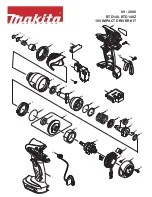
Page of 11
3
• Use safety equipment.
Always wear eye protection. Safety equipment such as dust mask, non-skid
safety shoes, hard hat, or hearing protection for appropriate conditions will reduce personal injuries.
• Dress properly.
Do not wear loose clothing or jewelry. Keep your hair, clothing and gloves away from
moving parts. Loose clothes, jewelry or long hair can be caught in moving parts. Air vents may cover
moving parts and should be avoided.
• Avoid accidental starting.
Ensure the switch is in the off position before plugging in. Carrying power tool
with your finger on the switch or plugging in power tools that have the switch on invites accidents.
• Remove any adjusting keys or wrenches before turning the power tool on.
A wrench or key that is
left attached to a rotating part of the tool may result in personal injury.
• Do not overreach.
Maintain proper footing and balance at all times. Loss of balance can cause an injury
in an unexpected situation
.
• If devices are provided for connection of dust extraction and collection facilities, ensure these are
connected and properly used.
Use of these devices can reduce dust related hazards.
• Do not use a ladder or unstable support.
Stable footing on a solid surface enables better control of the
tool in unexpected situations.
• Keep tool handles dry, clean and free from oil and grease.
Slippery handles cannot safely control the
tool.
TOOL USE AND CARE
•
Secure the workpiece.
Use clamp or other practical way to hold the workpiece to a stable platform. Holding the
workpiece by hand or against your body is unstable and may lead to loss of control.
• Do not force the power tool.
The tool will perform the job better and safer at the feed rate for which it is
designed. Forcing the tool could possibly damage the tool and may result in personal injury.
• Use the correct power tool for the job.
Don’t force the tool or attachment to do a job for which it is not
designed.
• Do not use tool if switch does not turn it on or off.
Any tool that cannot be controlled with the switch is
dangerous and must be repaired or replaced by an authorized service center
.
• Turn power tool off, and disconnect the plug
from the power source and/or battery pack from the power tool
before making any adjustments, changing the accessories, or storing the tools
.
Such preventive safety
measures reduce the risk of an accidental start up which may cause personal injury
.
• Store idle tool out of reach of children and other inexperienced persons.
It is dangerous in the hand of
untrained users.
• Maintain power tools with care.
Check for proper alignment and binding of moving parts, component
breaks, and any other conditions that may affect the tool’s operation. A guard or any other part that is
damaged must be properly repaired or replaced by an authorized service center to avoid risk of personal
injury.
• Use recommended accessories.
Using accessories and attachments not recommended by the
manufacturer or intended for use on this type tool may cause damage to the tool or result in personal injury
to the user. Consult the operator’s manual for recommended accessories.
• Keep cutting tools sharp and clean.
Properly maintained cutting tools with sharp cutting edges are less
likely to bind and are easier to control
.
• Feed the workpiece in the correct direction and speed.
Feed the workpiece into a blade, cutter, or
abrasive surface against the direction of the cutting tool’s direction of rotation only. Incorrectly feeding the
workpiece in the same direction may cause the workpiece to be thrown out at high speed.
• Never leave the tool running unattended, turn the power off.
Do not leave the tool until it comes to a
complete stop.





























